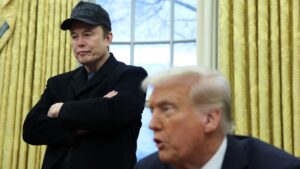The Economic Implications of Job Cuts in Washington D.C. as Trump Targets Federal Workforce
In recent months, the economic landscape of Washington D.C. has been shaken by President Donald Trump’s aggressive push to significantly reduce the federal workforce. This move has not only resulted in thousands of federal workers filing for unemployment, but it also raises questions about the broader implications for the economy, labor market trends, and the potential opportunities that may arise from such a drastic shift.
The Surge in Jobless Claims
Since the beginning of 2025, nearly 4,000 workers in Washington D.C. have filed for unemployment insurance, contributing to a larger trend of escalating jobless claims in the area. Data from the Labor Department reveals that in just six weeks, unemployment filings have soared by approximately 55% compared to the same period the previous year, with a spike reaching 1,780 claims in early February—up 36% from the prior week.
One may wonder how this correlates with the national trend. Interestingly, while D.C. sees a significant increase in jobless claims, the national average remains fairly stable, currently hovering around 216,000 claims. This contrast underscores the unique position of Washington D.C. amidst national labor market stability.
Understanding the Drivers Behind the Claims
The uptick in claims aligns closely with the administration’s recent directives, which include layoff orders and early retirement buyout programs. With approximately 75,000 employees already accepting buyout offers, the true impact of these moves may still be unfolding. Raj Namboothiry, senior vice president at Manpower North America, anticipates that jobless claims could continue to rise as the administration pursues its plans.
At present, D.C. has one of the highest unemployment rates in the country at 5.5%, trailing only Nevada. However, the surrounding metropolitan areas show a promising rate of 2.7%, indicative of regional disparities even within close proximities.
A Wider Economic Perspective: Stability Amidst Cuts
Despite the escalating claims in D.C., Namboothiry asserts that the national labor market remains "fairly stable." The cuts to the federal workforce could ignite challenges in the D.C. region, but given the array of geographies, skill sets, and sectors involved, the overall economic impact may be muted. It’s essential to note that the federal workforce has maintained a stable number since the 1960s, and the current reduction efforts are unprecedented in scope.
With approximately 2.4 million federal employees, workers may find themselves displaced, but they are likely to possess skills that are still in demand. Employers in sectors outside the federal umbrella could capitalize on the influx of talent, creating a unique hiring opportunity.
Silver Linings in a Changing Landscape
The impending layoffs may present not only challenges but also opportunities. Namboothiry suggests that employers may actively seek out displaced federal workers, particularly in industries experiencing a talent shortage. Certain fields, such as accounting, are thriving and could benefit from this shift in the workforce.
Allison Shrivastava, an economist at the Indeed Hiring Lab, emphasizes that the employment prospects for displaced workers will vary significantly based on their respective fields. While some sectors may experience a hiring boom, others, such as software development, may face a more challenging environment for job seekers.
Preparing for the Future: What You Should Know
At Extreme Investor Network, we believe that understanding these economic dynamics is crucial for both investors and job seekers alike. Following the trends in labor markets, particularly as they shift due to policy changes, can inform strategic investment decisions, as well as individualized career paths.
Key takeaways:
- Monitor Regional Trends: Keeping an eye on unemployment trends in Washington D.C. can provide insights into national labor market health.
- Adapt Skills for Demand: Workers within the federal sector should consider adapting their skills to align with sectors experiencing higher demand.
- Seize Opportunities: For investors, the shifting labor landscape could present opportunities in sectors poised for growth as talent shifts from government roles.
In summary, while the immediate future may seem uncertain for many federal workers in Washington D.C., there are potential opportunities that arise in their wake. By understanding the broader economic implications and acting strategically, individuals can navigate this ecosystem effectively. Stay tuned to Extreme Investor Network for the latest insights and expert analysis to help you make informed decisions in an ever-evolving economy.

